Understanding Expatriate Management and Global Talent Strategies
VerifiedAdded on 2020/04/07
|23
|6815
|343
AI Summary
The management of expatriates plays a crucial role in the success of multinational corporations (MNCs). This summary synthesizes key themes from existing literature that address various aspects of expatriate management. Central topics include the cross-cultural adjustment process for both individuals and families, which can significantly affect expatriate effectiveness and well-being. Additionally, knowledge transfer is vital as repatriated employees bring valuable international experience back to their home organizations, facilitating organizational learning and innovation. The strategic placement and performance management of expatriates are also discussed, highlighting the balance between subsidiary needs and corporate objectives. A significant focus on return on investment (ROI) for expatriate assignments reveals insights into aligning individual contributions with broader business goals. Furthermore, global talent strategies emphasize the role of self-initiated expatriates in achieving effective global talent management. The literature underscores the importance of organizational support systems, including training and development programs, to enhance expatriates' adjustment and performance outcomes. Overall, successful expatriate management requires a comprehensive approach that integrates individual, familial, organizational, and strategic considerations.
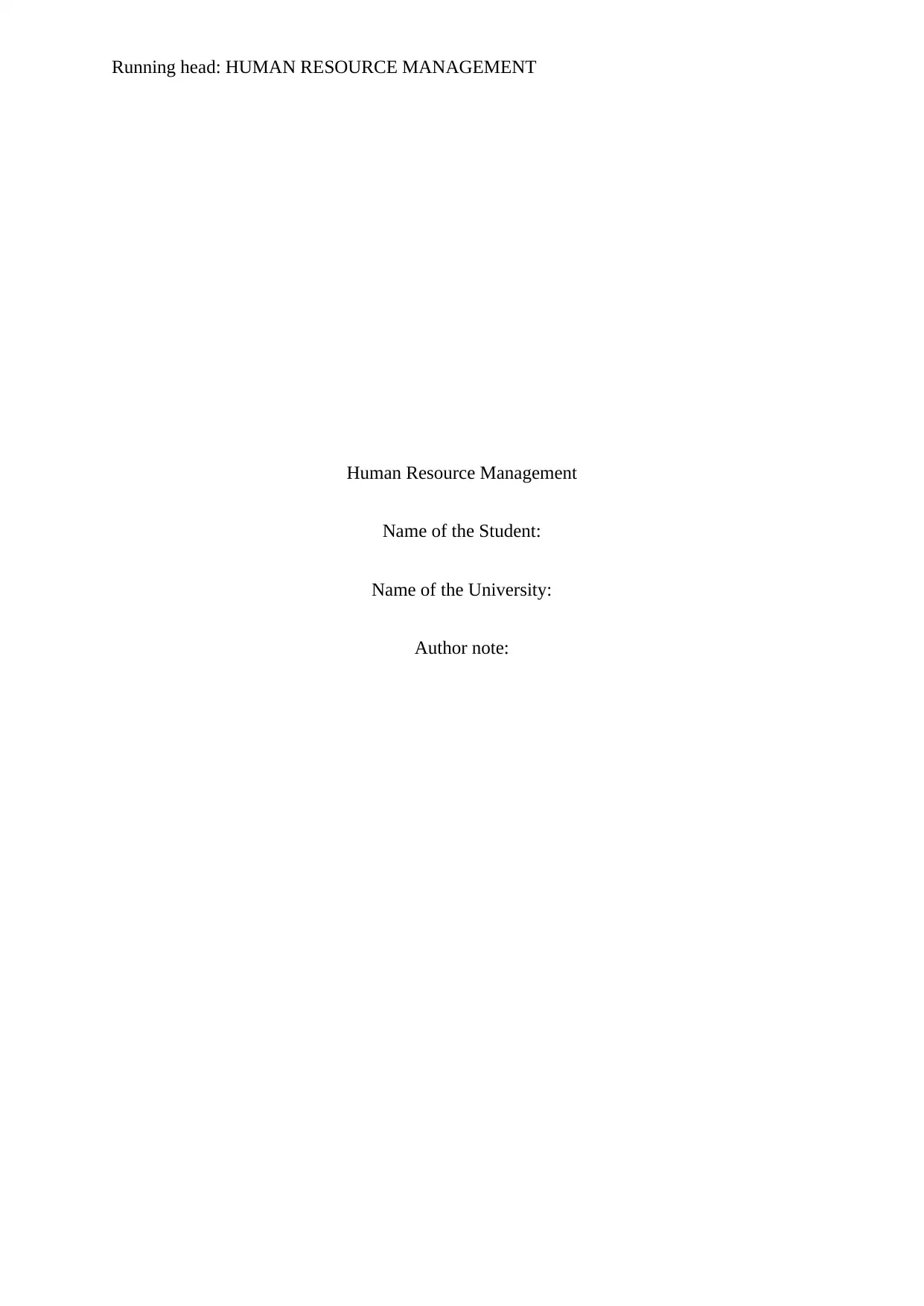
Running head: HUMAN RESOURCE MANAGEMENT
Human Resource Management
Name of the Student:
Name of the University:
Author note:
Human Resource Management
Name of the Student:
Name of the University:
Author note:
Paraphrase This Document
Need a fresh take? Get an instant paraphrase of this document with our AI Paraphraser

1HUMAN RESOURCE MANAGEMENT
1. Abstract
The study highlights the international organizations’ management of expatriate performances.
In modern days, majority of the multinational organizations send their employees to the
foreign countries in order to work in their branch offices or even subsidiaries. This helps in
improving the global coordination of the particular company. The expatriate workers are
more expensive than the local employees. Their salaries are comparatively higher than that of
the domestic employees. They are motivated and encouraged to work abroad and provided
with various allowances, which is beneficial for them and their family members. However,
some employees reject this offer due to the trouble in adjusting with the foreign countries’
working culture or environment. One of the major reasons for refusing such offer or
assignment, is family concern as well as spouse’s or child’s career.The workers are often
encouraged by their employers to take up those international assignments, for their personal
establishment.
Key words: Multinational Organization, Expatriate, Performance, Management, Encourage,
Working culture.
1. Abstract
The study highlights the international organizations’ management of expatriate performances.
In modern days, majority of the multinational organizations send their employees to the
foreign countries in order to work in their branch offices or even subsidiaries. This helps in
improving the global coordination of the particular company. The expatriate workers are
more expensive than the local employees. Their salaries are comparatively higher than that of
the domestic employees. They are motivated and encouraged to work abroad and provided
with various allowances, which is beneficial for them and their family members. However,
some employees reject this offer due to the trouble in adjusting with the foreign countries’
working culture or environment. One of the major reasons for refusing such offer or
assignment, is family concern as well as spouse’s or child’s career.The workers are often
encouraged by their employers to take up those international assignments, for their personal
establishment.
Key words: Multinational Organization, Expatriate, Performance, Management, Encourage,
Working culture.
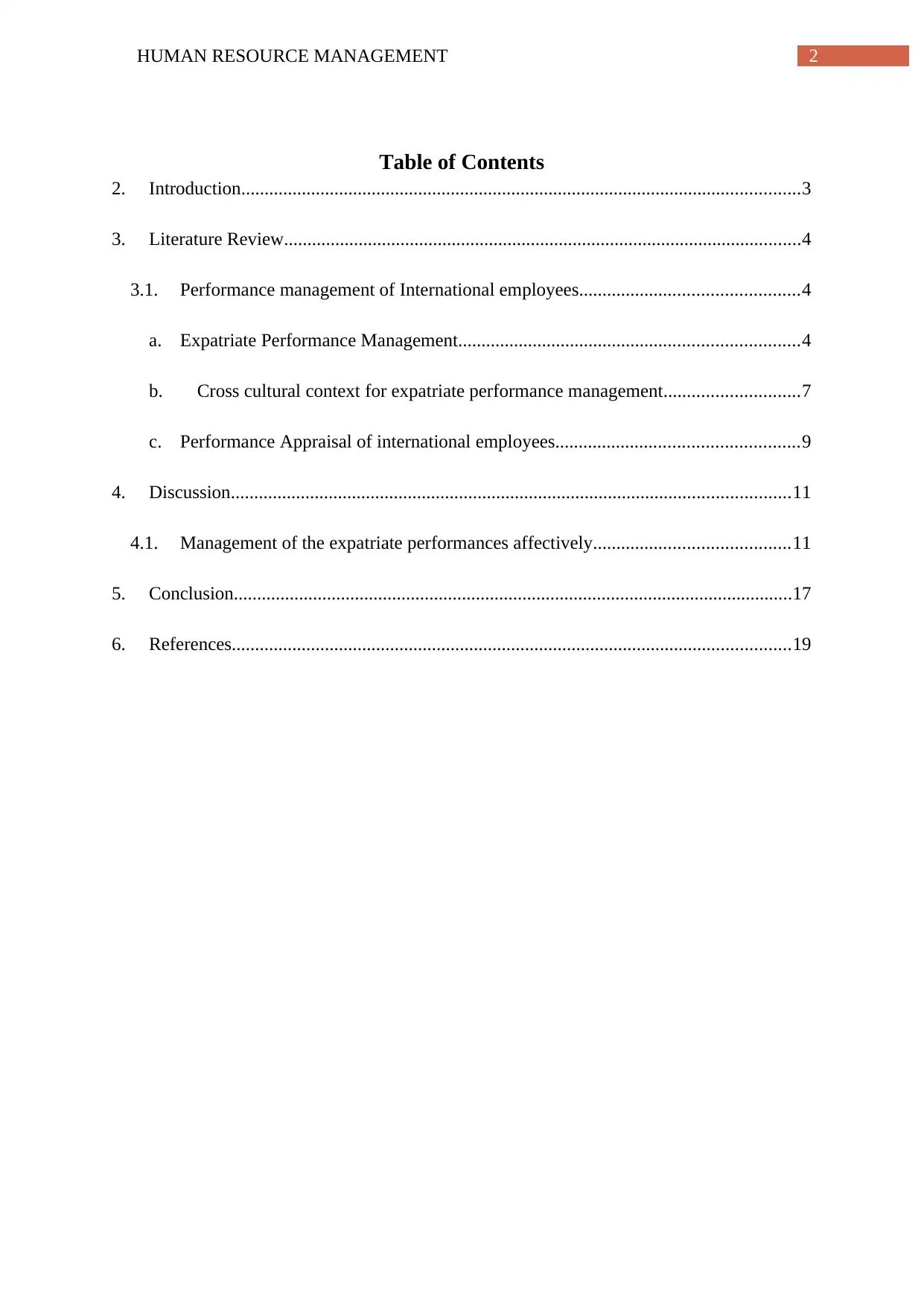
2HUMAN RESOURCE MANAGEMENT
Table of Contents
2. Introduction........................................................................................................................3
3. Literature Review...............................................................................................................4
3.1. Performance management of International employees...............................................4
a. Expatriate Performance Management.........................................................................4
b. Cross cultural context for expatriate performance management.............................7
c. Performance Appraisal of international employees....................................................9
4. Discussion........................................................................................................................11
4.1. Management of the expatriate performances affectively..........................................11
5. Conclusion........................................................................................................................17
6. References........................................................................................................................19
Table of Contents
2. Introduction........................................................................................................................3
3. Literature Review...............................................................................................................4
3.1. Performance management of International employees...............................................4
a. Expatriate Performance Management.........................................................................4
b. Cross cultural context for expatriate performance management.............................7
c. Performance Appraisal of international employees....................................................9
4. Discussion........................................................................................................................11
4.1. Management of the expatriate performances affectively..........................................11
5. Conclusion........................................................................................................................17
6. References........................................................................................................................19
⊘ This is a preview!⊘
Do you want full access?
Subscribe today to unlock all pages.

Trusted by 1+ million students worldwide
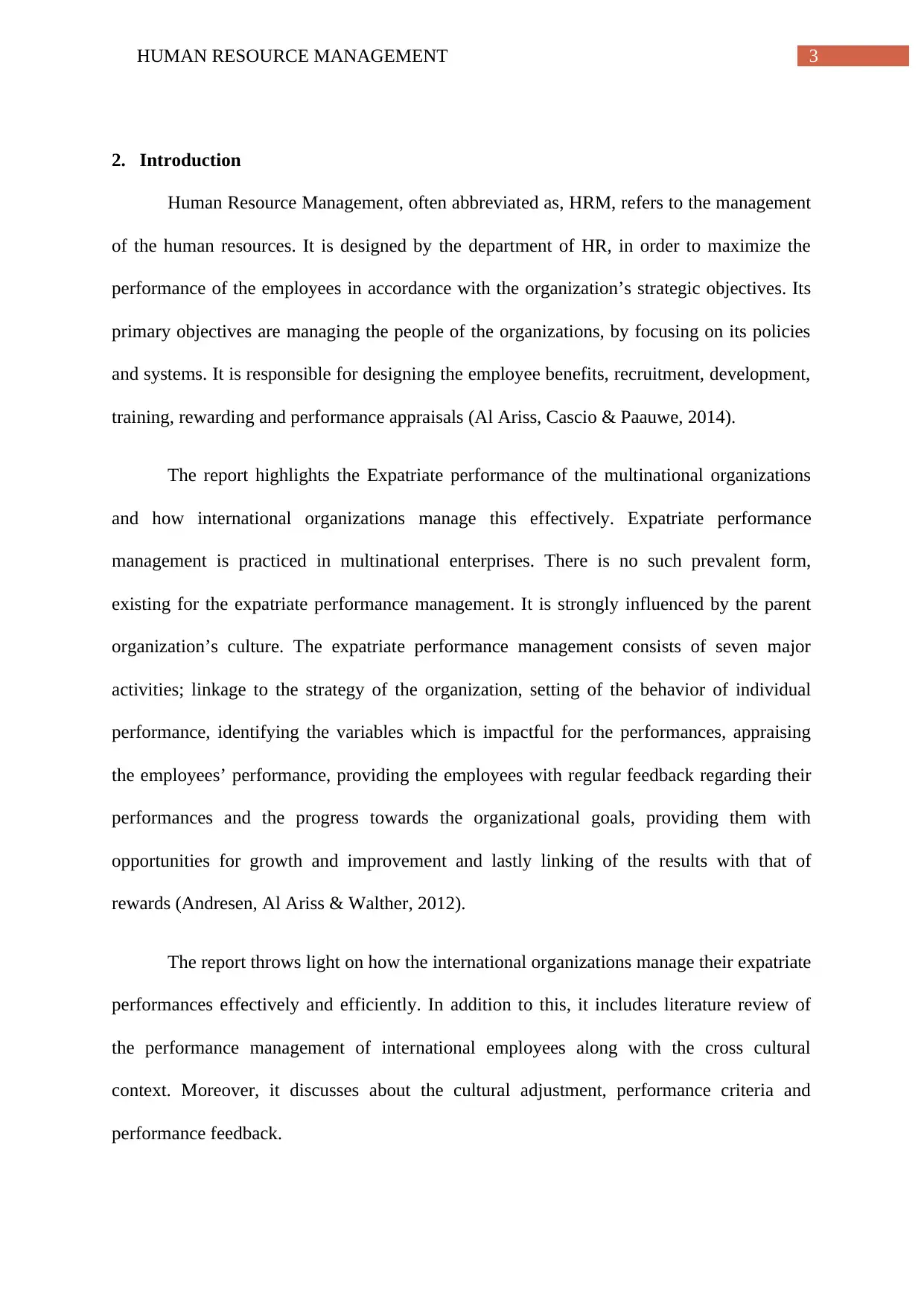
3HUMAN RESOURCE MANAGEMENT
2. Introduction
Human Resource Management, often abbreviated as, HRM, refers to the management
of the human resources. It is designed by the department of HR, in order to maximize the
performance of the employees in accordance with the organization’s strategic objectives. Its
primary objectives are managing the people of the organizations, by focusing on its policies
and systems. It is responsible for designing the employee benefits, recruitment, development,
training, rewarding and performance appraisals (Al Ariss, Cascio & Paauwe, 2014).
The report highlights the Expatriate performance of the multinational organizations
and how international organizations manage this effectively. Expatriate performance
management is practiced in multinational enterprises. There is no such prevalent form,
existing for the expatriate performance management. It is strongly influenced by the parent
organization’s culture. The expatriate performance management consists of seven major
activities; linkage to the strategy of the organization, setting of the behavior of individual
performance, identifying the variables which is impactful for the performances, appraising
the employees’ performance, providing the employees with regular feedback regarding their
performances and the progress towards the organizational goals, providing them with
opportunities for growth and improvement and lastly linking of the results with that of
rewards (Andresen, Al Ariss & Walther, 2012).
The report throws light on how the international organizations manage their expatriate
performances effectively and efficiently. In addition to this, it includes literature review of
the performance management of international employees along with the cross cultural
context. Moreover, it discusses about the cultural adjustment, performance criteria and
performance feedback.
2. Introduction
Human Resource Management, often abbreviated as, HRM, refers to the management
of the human resources. It is designed by the department of HR, in order to maximize the
performance of the employees in accordance with the organization’s strategic objectives. Its
primary objectives are managing the people of the organizations, by focusing on its policies
and systems. It is responsible for designing the employee benefits, recruitment, development,
training, rewarding and performance appraisals (Al Ariss, Cascio & Paauwe, 2014).
The report highlights the Expatriate performance of the multinational organizations
and how international organizations manage this effectively. Expatriate performance
management is practiced in multinational enterprises. There is no such prevalent form,
existing for the expatriate performance management. It is strongly influenced by the parent
organization’s culture. The expatriate performance management consists of seven major
activities; linkage to the strategy of the organization, setting of the behavior of individual
performance, identifying the variables which is impactful for the performances, appraising
the employees’ performance, providing the employees with regular feedback regarding their
performances and the progress towards the organizational goals, providing them with
opportunities for growth and improvement and lastly linking of the results with that of
rewards (Andresen, Al Ariss & Walther, 2012).
The report throws light on how the international organizations manage their expatriate
performances effectively and efficiently. In addition to this, it includes literature review of
the performance management of international employees along with the cross cultural
context. Moreover, it discusses about the cultural adjustment, performance criteria and
performance feedback.
Paraphrase This Document
Need a fresh take? Get an instant paraphrase of this document with our AI Paraphraser
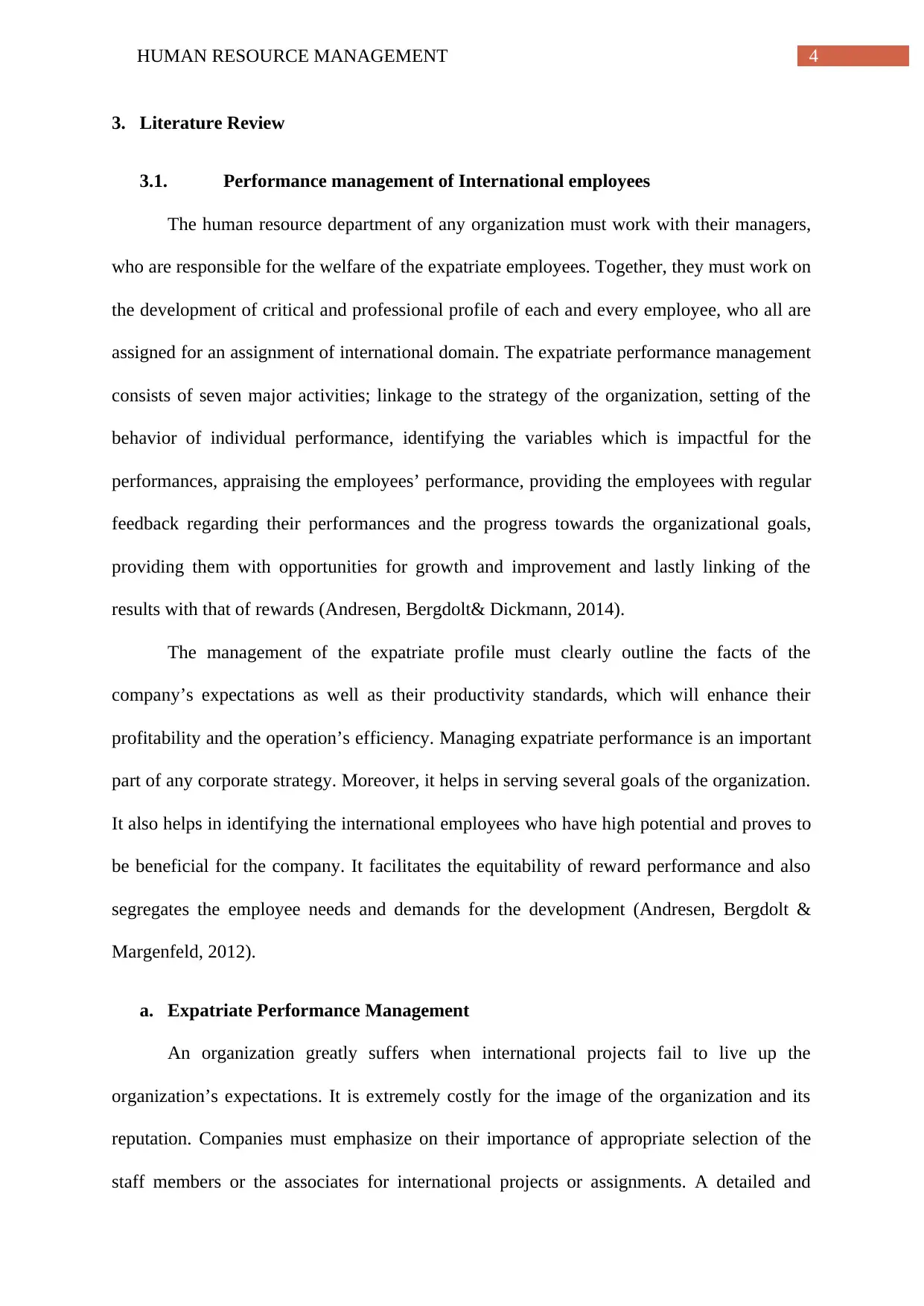
4HUMAN RESOURCE MANAGEMENT
3. Literature Review
3.1. Performance management of International employees
The human resource department of any organization must work with their managers,
who are responsible for the welfare of the expatriate employees. Together, they must work on
the development of critical and professional profile of each and every employee, who all are
assigned for an assignment of international domain. The expatriate performance management
consists of seven major activities; linkage to the strategy of the organization, setting of the
behavior of individual performance, identifying the variables which is impactful for the
performances, appraising the employees’ performance, providing the employees with regular
feedback regarding their performances and the progress towards the organizational goals,
providing them with opportunities for growth and improvement and lastly linking of the
results with that of rewards (Andresen, Bergdolt& Dickmann, 2014).
The management of the expatriate profile must clearly outline the facts of the
company’s expectations as well as their productivity standards, which will enhance their
profitability and the operation’s efficiency. Managing expatriate performance is an important
part of any corporate strategy. Moreover, it helps in serving several goals of the organization.
It also helps in identifying the international employees who have high potential and proves to
be beneficial for the company. It facilitates the equitability of reward performance and also
segregates the employee needs and demands for the development (Andresen, Bergdolt &
Margenfeld, 2012).
a. Expatriate Performance Management
An organization greatly suffers when international projects fail to live up the
organization’s expectations. It is extremely costly for the image of the organization and its
reputation. Companies must emphasize on their importance of appropriate selection of the
staff members or the associates for international projects or assignments. A detailed and
3. Literature Review
3.1. Performance management of International employees
The human resource department of any organization must work with their managers,
who are responsible for the welfare of the expatriate employees. Together, they must work on
the development of critical and professional profile of each and every employee, who all are
assigned for an assignment of international domain. The expatriate performance management
consists of seven major activities; linkage to the strategy of the organization, setting of the
behavior of individual performance, identifying the variables which is impactful for the
performances, appraising the employees’ performance, providing the employees with regular
feedback regarding their performances and the progress towards the organizational goals,
providing them with opportunities for growth and improvement and lastly linking of the
results with that of rewards (Andresen, Bergdolt& Dickmann, 2014).
The management of the expatriate profile must clearly outline the facts of the
company’s expectations as well as their productivity standards, which will enhance their
profitability and the operation’s efficiency. Managing expatriate performance is an important
part of any corporate strategy. Moreover, it helps in serving several goals of the organization.
It also helps in identifying the international employees who have high potential and proves to
be beneficial for the company. It facilitates the equitability of reward performance and also
segregates the employee needs and demands for the development (Andresen, Bergdolt &
Margenfeld, 2012).
a. Expatriate Performance Management
An organization greatly suffers when international projects fail to live up the
organization’s expectations. It is extremely costly for the image of the organization and its
reputation. Companies must emphasize on their importance of appropriate selection of the
staff members or the associates for international projects or assignments. A detailed and
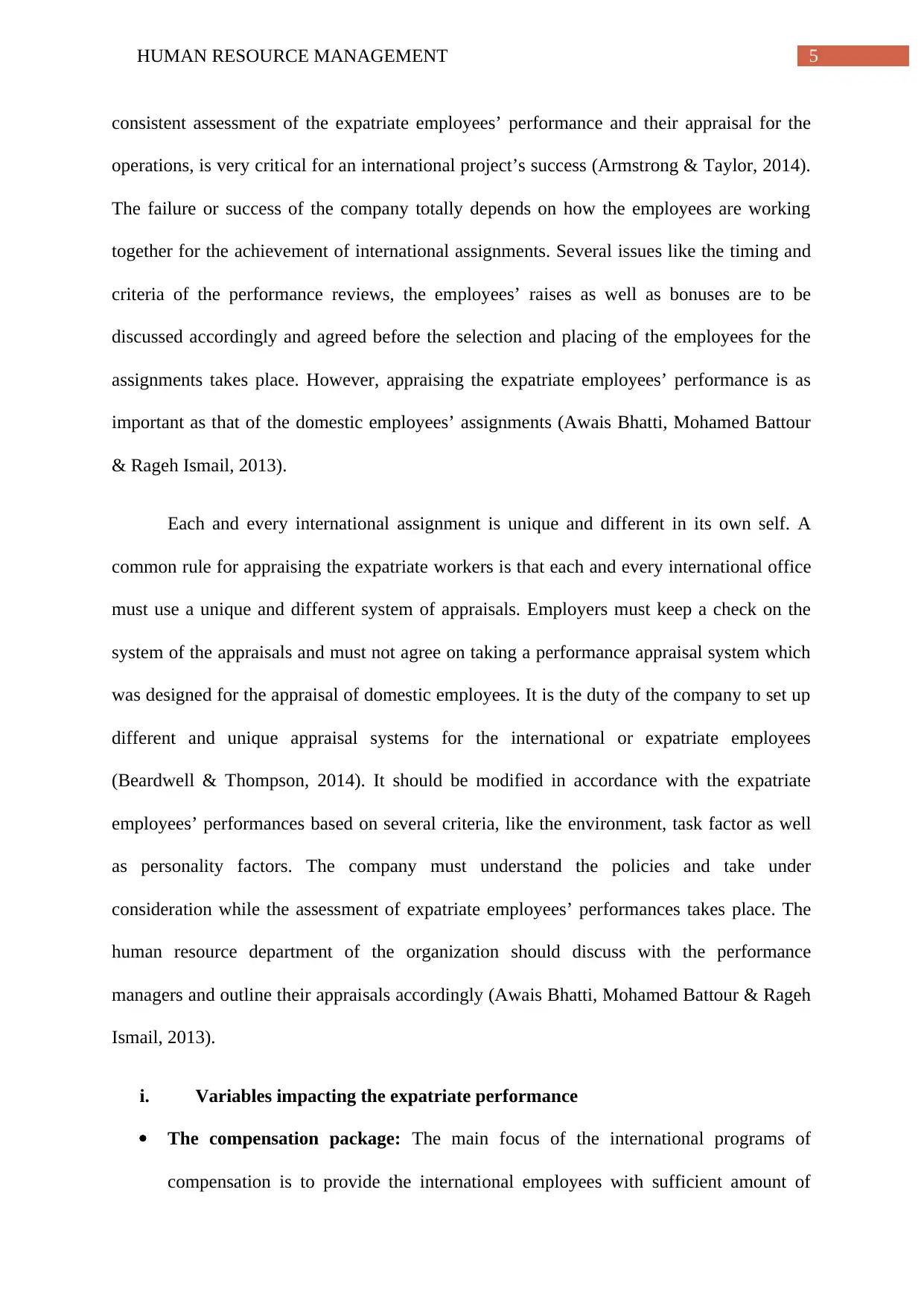
5HUMAN RESOURCE MANAGEMENT
consistent assessment of the expatriate employees’ performance and their appraisal for the
operations, is very critical for an international project’s success (Armstrong & Taylor, 2014).
The failure or success of the company totally depends on how the employees are working
together for the achievement of international assignments. Several issues like the timing and
criteria of the performance reviews, the employees’ raises as well as bonuses are to be
discussed accordingly and agreed before the selection and placing of the employees for the
assignments takes place. However, appraising the expatriate employees’ performance is as
important as that of the domestic employees’ assignments (Awais Bhatti, Mohamed Battour
& Rageh Ismail, 2013).
Each and every international assignment is unique and different in its own self. A
common rule for appraising the expatriate workers is that each and every international office
must use a unique and different system of appraisals. Employers must keep a check on the
system of the appraisals and must not agree on taking a performance appraisal system which
was designed for the appraisal of domestic employees. It is the duty of the company to set up
different and unique appraisal systems for the international or expatriate employees
(Beardwell & Thompson, 2014). It should be modified in accordance with the expatriate
employees’ performances based on several criteria, like the environment, task factor as well
as personality factors. The company must understand the policies and take under
consideration while the assessment of expatriate employees’ performances takes place. The
human resource department of the organization should discuss with the performance
managers and outline their appraisals accordingly (Awais Bhatti, Mohamed Battour & Rageh
Ismail, 2013).
i. Variables impacting the expatriate performance
The compensation package: The main focus of the international programs of
compensation is to provide the international employees with sufficient amount of
consistent assessment of the expatriate employees’ performance and their appraisal for the
operations, is very critical for an international project’s success (Armstrong & Taylor, 2014).
The failure or success of the company totally depends on how the employees are working
together for the achievement of international assignments. Several issues like the timing and
criteria of the performance reviews, the employees’ raises as well as bonuses are to be
discussed accordingly and agreed before the selection and placing of the employees for the
assignments takes place. However, appraising the expatriate employees’ performance is as
important as that of the domestic employees’ assignments (Awais Bhatti, Mohamed Battour
& Rageh Ismail, 2013).
Each and every international assignment is unique and different in its own self. A
common rule for appraising the expatriate workers is that each and every international office
must use a unique and different system of appraisals. Employers must keep a check on the
system of the appraisals and must not agree on taking a performance appraisal system which
was designed for the appraisal of domestic employees. It is the duty of the company to set up
different and unique appraisal systems for the international or expatriate employees
(Beardwell & Thompson, 2014). It should be modified in accordance with the expatriate
employees’ performances based on several criteria, like the environment, task factor as well
as personality factors. The company must understand the policies and take under
consideration while the assessment of expatriate employees’ performances takes place. The
human resource department of the organization should discuss with the performance
managers and outline their appraisals accordingly (Awais Bhatti, Mohamed Battour & Rageh
Ismail, 2013).
i. Variables impacting the expatriate performance
The compensation package: The main focus of the international programs of
compensation is to provide the international employees with sufficient amount of
⊘ This is a preview!⊘
Do you want full access?
Subscribe today to unlock all pages.

Trusted by 1+ million students worldwide

6HUMAN RESOURCE MANAGEMENT
wages in order to keep them at a good financial level, at the point of their
international projects. They must not lose their ground economically. The
compensation package must include the normal salary, in addition to the benefits
being offered in the employees’ home countries. For expatriate employees, the base
salary is the primary allowance packages, which includes foreign premium services,
living cost allowances, utility and housing allowances, in service benefits as well as
pension contributions. It may be paid in local or home currency or in dollar, pound
and others (Bratton & Gold, 2012).
Headquarter Support: The headquarters’ support is a very important factor. It
should extend from the individual expatriate employee to his/her family members.
The external context acts as an important determinant for the expatriate employees’
performances. The contexts differ on the basis of societal, economical, legal,
technical, operational and physical factors. Headquarters’ support plays a bigger role
in the expatriates’ performances. If the expatriate performance is not managed
carefully then it may hamper the progress. Employees may suffer from sleep
disturbances, anxiety, stress, health disorders and others. Therefore, it is to be taken
care and headquarters must fully support in order to enhance their performance levels
(Cerdin & Brewster, 2014).
Cultural Adjustment:Expatriates’ performances are mediated by the adoption of
cross cultural factors. Managers of any organization must be aware of certain skills
which are necessary for creating and maintaining a successful and diverse workforce.
Firstly, they must take care that none of its employees are facing discrimination and
stereotyping. Managers must be aware of its consequences. They must be able to
recognize their own cultural prejudices and biasness so that they can work on it. They
must change the organization’s working procedure when it is necessary.
wages in order to keep them at a good financial level, at the point of their
international projects. They must not lose their ground economically. The
compensation package must include the normal salary, in addition to the benefits
being offered in the employees’ home countries. For expatriate employees, the base
salary is the primary allowance packages, which includes foreign premium services,
living cost allowances, utility and housing allowances, in service benefits as well as
pension contributions. It may be paid in local or home currency or in dollar, pound
and others (Bratton & Gold, 2012).
Headquarter Support: The headquarters’ support is a very important factor. It
should extend from the individual expatriate employee to his/her family members.
The external context acts as an important determinant for the expatriate employees’
performances. The contexts differ on the basis of societal, economical, legal,
technical, operational and physical factors. Headquarters’ support plays a bigger role
in the expatriates’ performances. If the expatriate performance is not managed
carefully then it may hamper the progress. Employees may suffer from sleep
disturbances, anxiety, stress, health disorders and others. Therefore, it is to be taken
care and headquarters must fully support in order to enhance their performance levels
(Cerdin & Brewster, 2014).
Cultural Adjustment:Expatriates’ performances are mediated by the adoption of
cross cultural factors. Managers of any organization must be aware of certain skills
which are necessary for creating and maintaining a successful and diverse workforce.
Firstly, they must take care that none of its employees are facing discrimination and
stereotyping. Managers must be aware of its consequences. They must be able to
recognize their own cultural prejudices and biasness so that they can work on it. They
must change the organization’s working procedure when it is necessary.
Paraphrase This Document
Need a fresh take? Get an instant paraphrase of this document with our AI Paraphraser
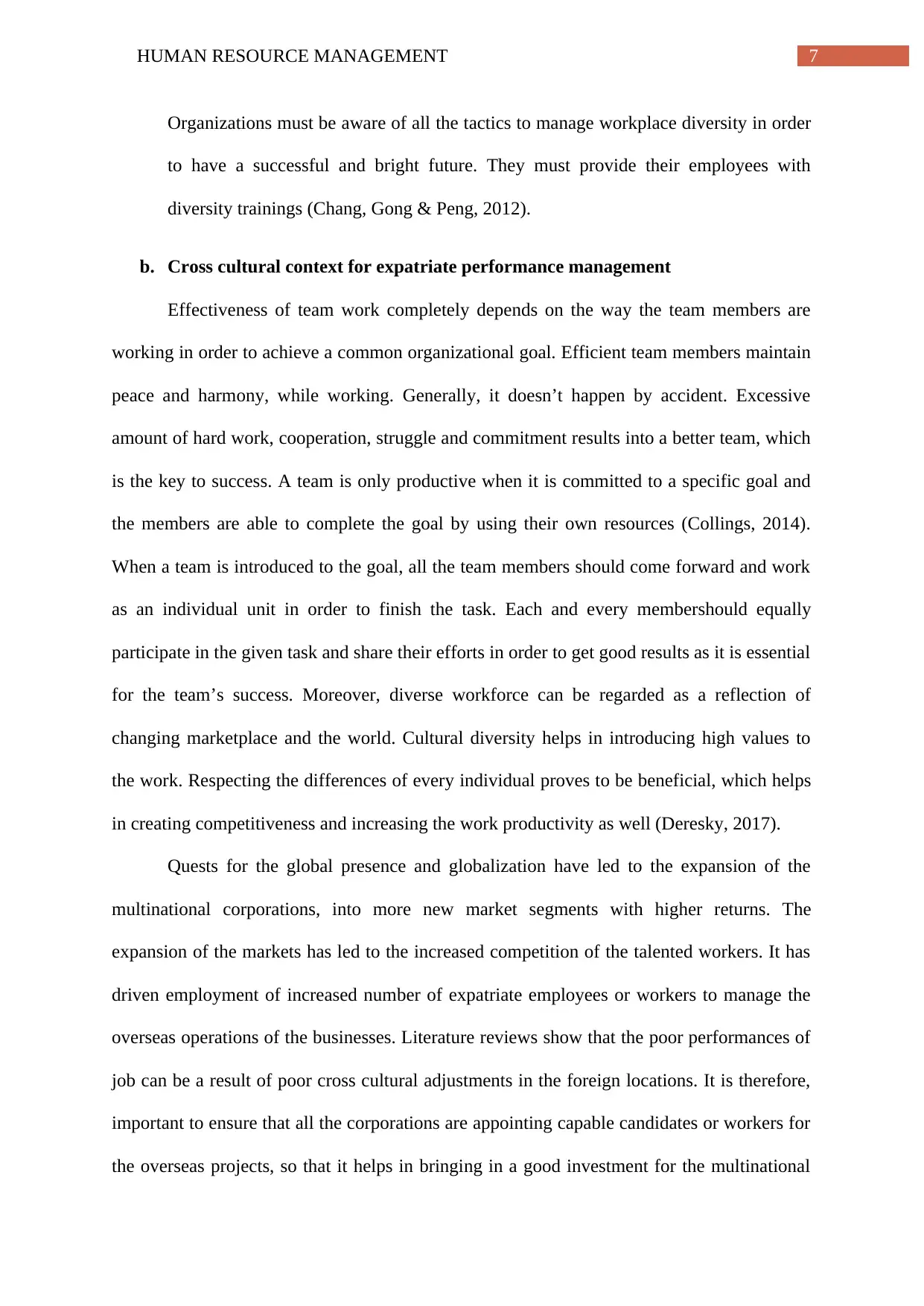
7HUMAN RESOURCE MANAGEMENT
Organizations must be aware of all the tactics to manage workplace diversity in order
to have a successful and bright future. They must provide their employees with
diversity trainings (Chang, Gong & Peng, 2012).
b. Cross cultural context for expatriate performance management
Effectiveness of team work completely depends on the way the team members are
working in order to achieve a common organizational goal. Efficient team members maintain
peace and harmony, while working. Generally, it doesn’t happen by accident. Excessive
amount of hard work, cooperation, struggle and commitment results into a better team, which
is the key to success. A team is only productive when it is committed to a specific goal and
the members are able to complete the goal by using their own resources (Collings, 2014).
When a team is introduced to the goal, all the team members should come forward and work
as an individual unit in order to finish the task. Each and every membershould equally
participate in the given task and share their efforts in order to get good results as it is essential
for the team’s success. Moreover, diverse workforce can be regarded as a reflection of
changing marketplace and the world. Cultural diversity helps in introducing high values to
the work. Respecting the differences of every individual proves to be beneficial, which helps
in creating competitiveness and increasing the work productivity as well (Deresky, 2017).
Quests for the global presence and globalization have led to the expansion of the
multinational corporations, into more new market segments with higher returns. The
expansion of the markets has led to the increased competition of the talented workers. It has
driven employment of increased number of expatriate employees or workers to manage the
overseas operations of the businesses. Literature reviews show that the poor performances of
job can be a result of poor cross cultural adjustments in the foreign locations. It is therefore,
important to ensure that all the corporations are appointing capable candidates or workers for
the overseas projects, so that it helps in bringing in a good investment for the multinational
Organizations must be aware of all the tactics to manage workplace diversity in order
to have a successful and bright future. They must provide their employees with
diversity trainings (Chang, Gong & Peng, 2012).
b. Cross cultural context for expatriate performance management
Effectiveness of team work completely depends on the way the team members are
working in order to achieve a common organizational goal. Efficient team members maintain
peace and harmony, while working. Generally, it doesn’t happen by accident. Excessive
amount of hard work, cooperation, struggle and commitment results into a better team, which
is the key to success. A team is only productive when it is committed to a specific goal and
the members are able to complete the goal by using their own resources (Collings, 2014).
When a team is introduced to the goal, all the team members should come forward and work
as an individual unit in order to finish the task. Each and every membershould equally
participate in the given task and share their efforts in order to get good results as it is essential
for the team’s success. Moreover, diverse workforce can be regarded as a reflection of
changing marketplace and the world. Cultural diversity helps in introducing high values to
the work. Respecting the differences of every individual proves to be beneficial, which helps
in creating competitiveness and increasing the work productivity as well (Deresky, 2017).
Quests for the global presence and globalization have led to the expansion of the
multinational corporations, into more new market segments with higher returns. The
expansion of the markets has led to the increased competition of the talented workers. It has
driven employment of increased number of expatriate employees or workers to manage the
overseas operations of the businesses. Literature reviews show that the poor performances of
job can be a result of poor cross cultural adjustments in the foreign locations. It is therefore,
important to ensure that all the corporations are appointing capable candidates or workers for
the overseas projects, so that it helps in bringing in a good investment for the multinational
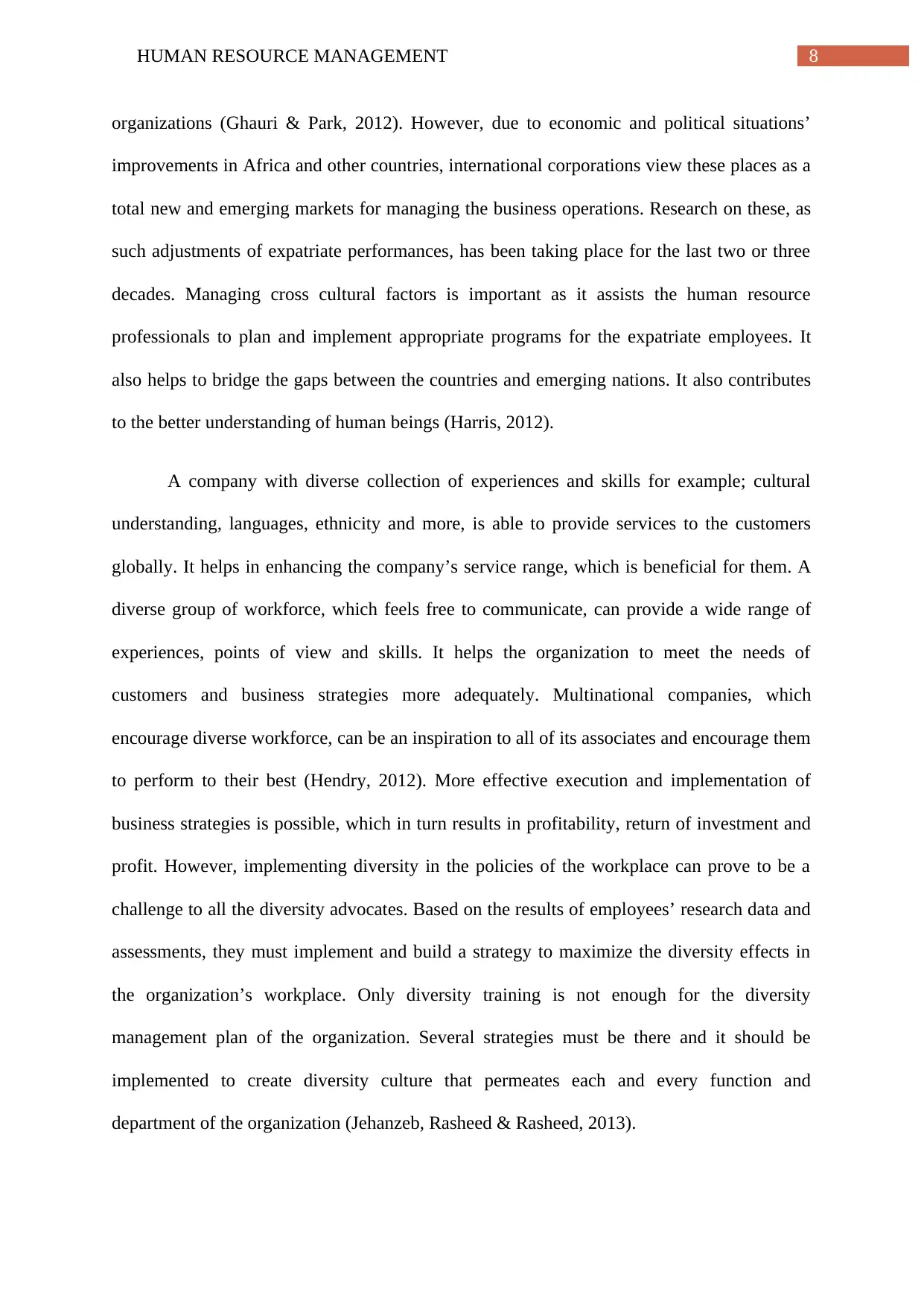
8HUMAN RESOURCE MANAGEMENT
organizations (Ghauri & Park, 2012). However, due to economic and political situations’
improvements in Africa and other countries, international corporations view these places as a
total new and emerging markets for managing the business operations. Research on these, as
such adjustments of expatriate performances, has been taking place for the last two or three
decades. Managing cross cultural factors is important as it assists the human resource
professionals to plan and implement appropriate programs for the expatriate employees. It
also helps to bridge the gaps between the countries and emerging nations. It also contributes
to the better understanding of human beings (Harris, 2012).
A company with diverse collection of experiences and skills for example; cultural
understanding, languages, ethnicity and more, is able to provide services to the customers
globally. It helps in enhancing the company’s service range, which is beneficial for them. A
diverse group of workforce, which feels free to communicate, can provide a wide range of
experiences, points of view and skills. It helps the organization to meet the needs of
customers and business strategies more adequately. Multinational companies, which
encourage diverse workforce, can be an inspiration to all of its associates and encourage them
to perform to their best (Hendry, 2012). More effective execution and implementation of
business strategies is possible, which in turn results in profitability, return of investment and
profit. However, implementing diversity in the policies of the workplace can prove to be a
challenge to all the diversity advocates. Based on the results of employees’ research data and
assessments, they must implement and build a strategy to maximize the diversity effects in
the organization’s workplace. Only diversity training is not enough for the diversity
management plan of the organization. Several strategies must be there and it should be
implemented to create diversity culture that permeates each and every function and
department of the organization (Jehanzeb, Rasheed & Rasheed, 2013).
organizations (Ghauri & Park, 2012). However, due to economic and political situations’
improvements in Africa and other countries, international corporations view these places as a
total new and emerging markets for managing the business operations. Research on these, as
such adjustments of expatriate performances, has been taking place for the last two or three
decades. Managing cross cultural factors is important as it assists the human resource
professionals to plan and implement appropriate programs for the expatriate employees. It
also helps to bridge the gaps between the countries and emerging nations. It also contributes
to the better understanding of human beings (Harris, 2012).
A company with diverse collection of experiences and skills for example; cultural
understanding, languages, ethnicity and more, is able to provide services to the customers
globally. It helps in enhancing the company’s service range, which is beneficial for them. A
diverse group of workforce, which feels free to communicate, can provide a wide range of
experiences, points of view and skills. It helps the organization to meet the needs of
customers and business strategies more adequately. Multinational companies, which
encourage diverse workforce, can be an inspiration to all of its associates and encourage them
to perform to their best (Hendry, 2012). More effective execution and implementation of
business strategies is possible, which in turn results in profitability, return of investment and
profit. However, implementing diversity in the policies of the workplace can prove to be a
challenge to all the diversity advocates. Based on the results of employees’ research data and
assessments, they must implement and build a strategy to maximize the diversity effects in
the organization’s workplace. Only diversity training is not enough for the diversity
management plan of the organization. Several strategies must be there and it should be
implemented to create diversity culture that permeates each and every function and
department of the organization (Jehanzeb, Rasheed & Rasheed, 2013).
⊘ This is a preview!⊘
Do you want full access?
Subscribe today to unlock all pages.

Trusted by 1+ million students worldwide
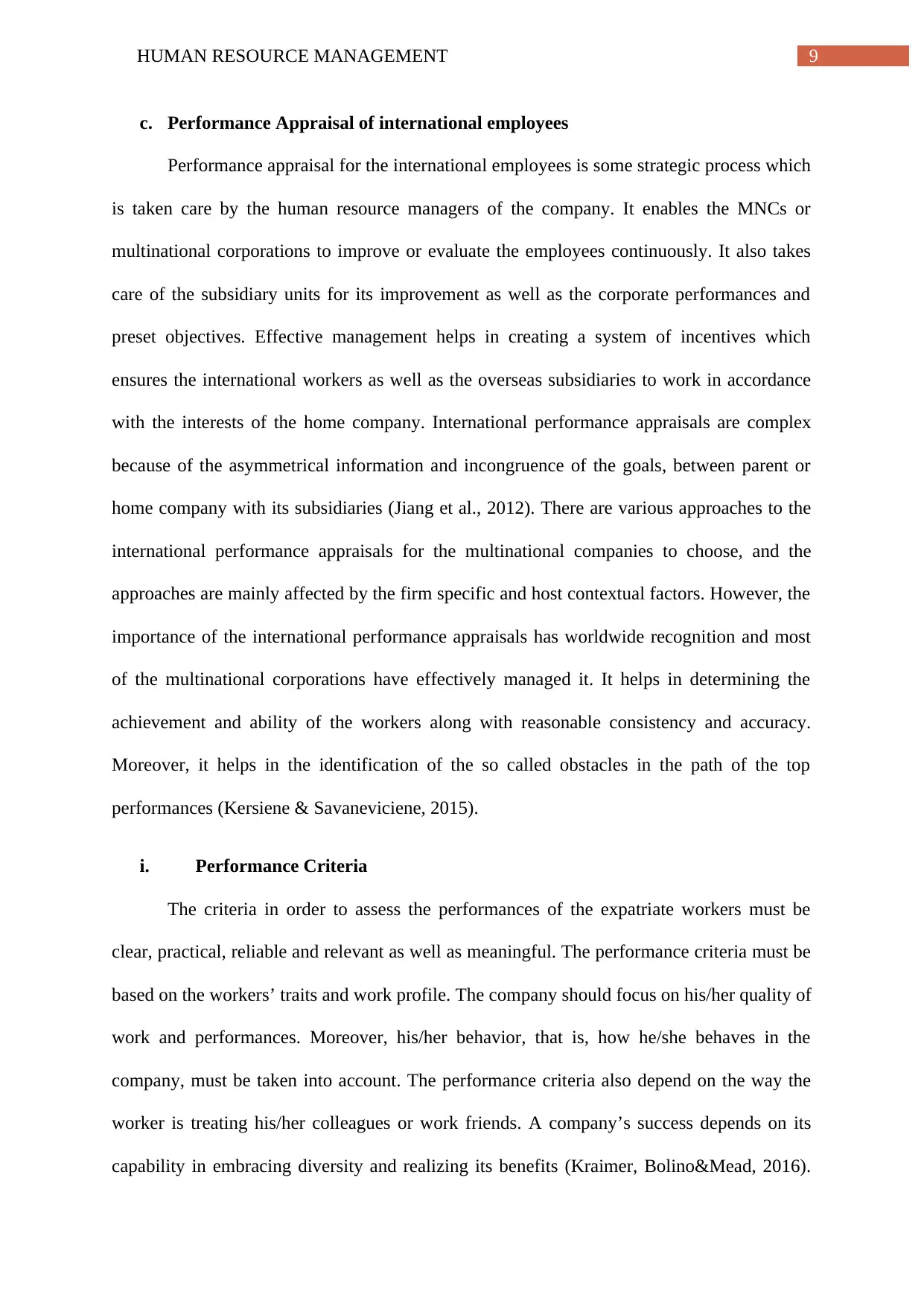
9HUMAN RESOURCE MANAGEMENT
c. Performance Appraisal of international employees
Performance appraisal for the international employees is some strategic process which
is taken care by the human resource managers of the company. It enables the MNCs or
multinational corporations to improve or evaluate the employees continuously. It also takes
care of the subsidiary units for its improvement as well as the corporate performances and
preset objectives. Effective management helps in creating a system of incentives which
ensures the international workers as well as the overseas subsidiaries to work in accordance
with the interests of the home company. International performance appraisals are complex
because of the asymmetrical information and incongruence of the goals, between parent or
home company with its subsidiaries (Jiang et al., 2012). There are various approaches to the
international performance appraisals for the multinational companies to choose, and the
approaches are mainly affected by the firm specific and host contextual factors. However, the
importance of the international performance appraisals has worldwide recognition and most
of the multinational corporations have effectively managed it. It helps in determining the
achievement and ability of the workers along with reasonable consistency and accuracy.
Moreover, it helps in the identification of the so called obstacles in the path of the top
performances (Kersiene & Savaneviciene, 2015).
i. Performance Criteria
The criteria in order to assess the performances of the expatriate workers must be
clear, practical, reliable and relevant as well as meaningful. The performance criteria must be
based on the workers’ traits and work profile. The company should focus on his/her quality of
work and performances. Moreover, his/her behavior, that is, how he/she behaves in the
company, must be taken into account. The performance criteria also depend on the way the
worker is treating his/her colleagues or work friends. A company’s success depends on its
capability in embracing diversity and realizing its benefits (Kraimer, Bolino&Mead, 2016).
c. Performance Appraisal of international employees
Performance appraisal for the international employees is some strategic process which
is taken care by the human resource managers of the company. It enables the MNCs or
multinational corporations to improve or evaluate the employees continuously. It also takes
care of the subsidiary units for its improvement as well as the corporate performances and
preset objectives. Effective management helps in creating a system of incentives which
ensures the international workers as well as the overseas subsidiaries to work in accordance
with the interests of the home company. International performance appraisals are complex
because of the asymmetrical information and incongruence of the goals, between parent or
home company with its subsidiaries (Jiang et al., 2012). There are various approaches to the
international performance appraisals for the multinational companies to choose, and the
approaches are mainly affected by the firm specific and host contextual factors. However, the
importance of the international performance appraisals has worldwide recognition and most
of the multinational corporations have effectively managed it. It helps in determining the
achievement and ability of the workers along with reasonable consistency and accuracy.
Moreover, it helps in the identification of the so called obstacles in the path of the top
performances (Kersiene & Savaneviciene, 2015).
i. Performance Criteria
The criteria in order to assess the performances of the expatriate workers must be
clear, practical, reliable and relevant as well as meaningful. The performance criteria must be
based on the workers’ traits and work profile. The company should focus on his/her quality of
work and performances. Moreover, his/her behavior, that is, how he/she behaves in the
company, must be taken into account. The performance criteria also depend on the way the
worker is treating his/her colleagues or work friends. A company’s success depends on its
capability in embracing diversity and realizing its benefits (Kraimer, Bolino&Mead, 2016).
Paraphrase This Document
Need a fresh take? Get an instant paraphrase of this document with our AI Paraphraser

10HUMAN RESOURCE MANAGEMENT
The organizations which are able to handle actively multiple issues related to diversity can
progress on a long run. It increases adaptability as employees with various backgrounds bring
in individual experiences and talents, giving new ideas and sharing different views which
help in adapting to customer demands and fluctuating markets. The multinational companies
must be able to establish the performance standards of the employees by encouraging them
on a daily basis. They must communicate their working standards to the employees to
increase their level of performance. Moreover, daily report of the expatriate workers’
performance must be kept in record and observed by the human resource managers (McEvoy
& Buller, 2013).
ii. Performance Feedback
However, establishing the performance criteria can be a difficult task altogether. This
is due to the major differences in the equitable standards of productivity and international
environments, which are applicable for the servicing and manufacturing of subsidiaries of
foreign companies. Performance feedbacks and criteria are being best established by
combining norms and values of each and every local environment with home office’s
standards of performances (McNulty, 2013). Individual profile of the countries must be
developed and they should take the foreign environment of subsidiaries into account. This
particular profile must be used in order to review certain factors which may have an
impactful effect on the performances of expatriate employees. Such factors are language,
politics, culture, labor relations, government, control, economy and communication. Once
these factors affecting the performances of expatriate employees are determined, the message
must be circulated among the subsidiaries of the multinational organizations and feedback
must be generated on the basis of that (McNulty, De Cieri & Hutchings, 2013). Critical and
professional profiles of each and every expatriate worker must be compared against the other
employees within the country cluster in order to ensure that the performance is properly
The organizations which are able to handle actively multiple issues related to diversity can
progress on a long run. It increases adaptability as employees with various backgrounds bring
in individual experiences and talents, giving new ideas and sharing different views which
help in adapting to customer demands and fluctuating markets. The multinational companies
must be able to establish the performance standards of the employees by encouraging them
on a daily basis. They must communicate their working standards to the employees to
increase their level of performance. Moreover, daily report of the expatriate workers’
performance must be kept in record and observed by the human resource managers (McEvoy
& Buller, 2013).
ii. Performance Feedback
However, establishing the performance criteria can be a difficult task altogether. This
is due to the major differences in the equitable standards of productivity and international
environments, which are applicable for the servicing and manufacturing of subsidiaries of
foreign companies. Performance feedbacks and criteria are being best established by
combining norms and values of each and every local environment with home office’s
standards of performances (McNulty, 2013). Individual profile of the countries must be
developed and they should take the foreign environment of subsidiaries into account. This
particular profile must be used in order to review certain factors which may have an
impactful effect on the performances of expatriate employees. Such factors are language,
politics, culture, labor relations, government, control, economy and communication. Once
these factors affecting the performances of expatriate employees are determined, the message
must be circulated among the subsidiaries of the multinational organizations and feedback
must be generated on the basis of that (McNulty, De Cieri & Hutchings, 2013). Critical and
professional profiles of each and every expatriate worker must be compared against the other
employees within the country cluster in order to ensure that the performance is properly
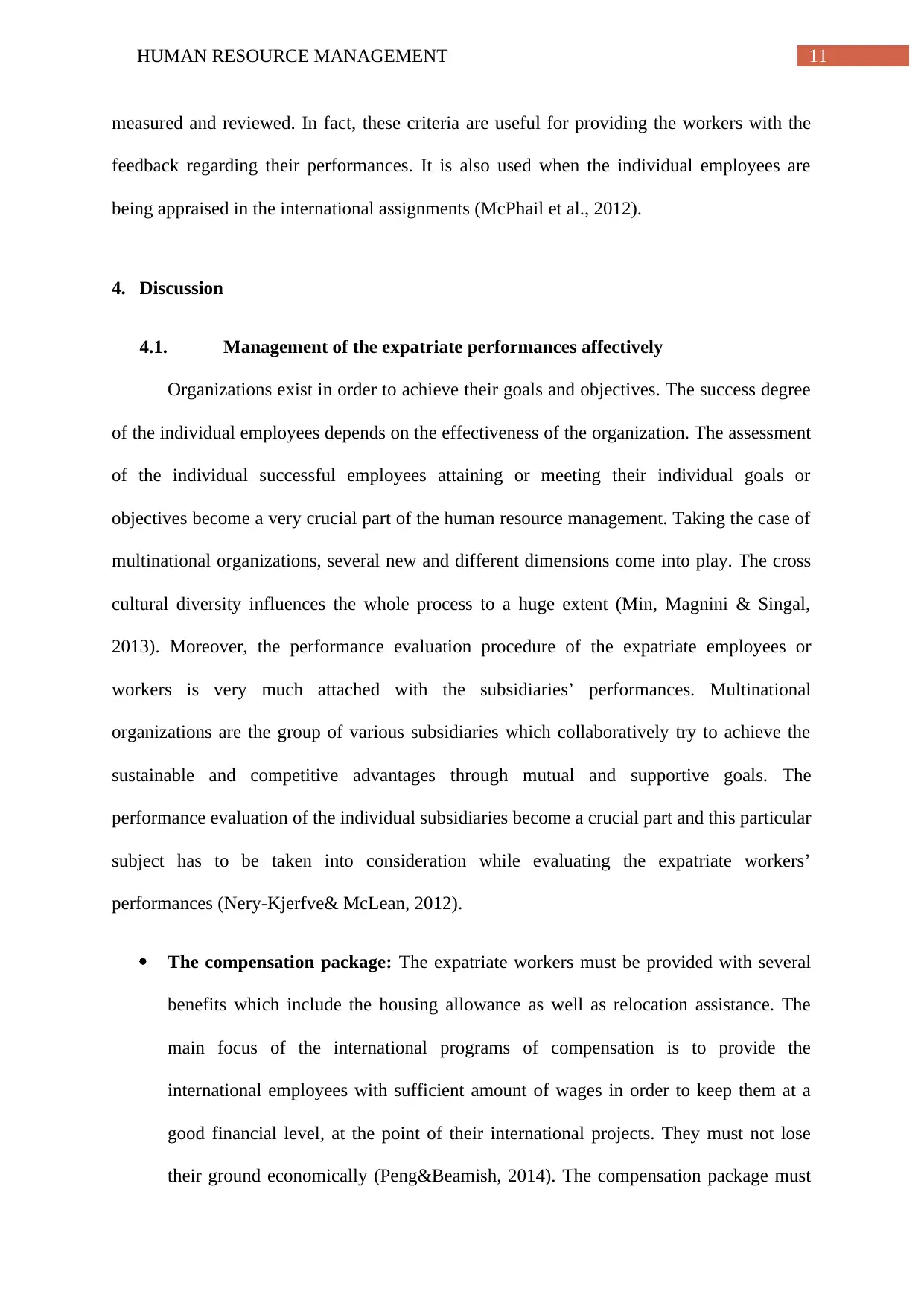
11HUMAN RESOURCE MANAGEMENT
measured and reviewed. In fact, these criteria are useful for providing the workers with the
feedback regarding their performances. It is also used when the individual employees are
being appraised in the international assignments (McPhail et al., 2012).
4. Discussion
4.1. Management of the expatriate performances affectively
Organizations exist in order to achieve their goals and objectives. The success degree
of the individual employees depends on the effectiveness of the organization. The assessment
of the individual successful employees attaining or meeting their individual goals or
objectives become a very crucial part of the human resource management. Taking the case of
multinational organizations, several new and different dimensions come into play. The cross
cultural diversity influences the whole process to a huge extent (Min, Magnini & Singal,
2013). Moreover, the performance evaluation procedure of the expatriate employees or
workers is very much attached with the subsidiaries’ performances. Multinational
organizations are the group of various subsidiaries which collaboratively try to achieve the
sustainable and competitive advantages through mutual and supportive goals. The
performance evaluation of the individual subsidiaries become a crucial part and this particular
subject has to be taken into consideration while evaluating the expatriate workers’
performances (Nery-Kjerfve& McLean, 2012).
The compensation package: The expatriate workers must be provided with several
benefits which include the housing allowance as well as relocation assistance. The
main focus of the international programs of compensation is to provide the
international employees with sufficient amount of wages in order to keep them at a
good financial level, at the point of their international projects. They must not lose
their ground economically (Peng&Beamish, 2014). The compensation package must
measured and reviewed. In fact, these criteria are useful for providing the workers with the
feedback regarding their performances. It is also used when the individual employees are
being appraised in the international assignments (McPhail et al., 2012).
4. Discussion
4.1. Management of the expatriate performances affectively
Organizations exist in order to achieve their goals and objectives. The success degree
of the individual employees depends on the effectiveness of the organization. The assessment
of the individual successful employees attaining or meeting their individual goals or
objectives become a very crucial part of the human resource management. Taking the case of
multinational organizations, several new and different dimensions come into play. The cross
cultural diversity influences the whole process to a huge extent (Min, Magnini & Singal,
2013). Moreover, the performance evaluation procedure of the expatriate employees or
workers is very much attached with the subsidiaries’ performances. Multinational
organizations are the group of various subsidiaries which collaboratively try to achieve the
sustainable and competitive advantages through mutual and supportive goals. The
performance evaluation of the individual subsidiaries become a crucial part and this particular
subject has to be taken into consideration while evaluating the expatriate workers’
performances (Nery-Kjerfve& McLean, 2012).
The compensation package: The expatriate workers must be provided with several
benefits which include the housing allowance as well as relocation assistance. The
main focus of the international programs of compensation is to provide the
international employees with sufficient amount of wages in order to keep them at a
good financial level, at the point of their international projects. They must not lose
their ground economically (Peng&Beamish, 2014). The compensation package must
⊘ This is a preview!⊘
Do you want full access?
Subscribe today to unlock all pages.

Trusted by 1+ million students worldwide
1 out of 23
Related Documents
Your All-in-One AI-Powered Toolkit for Academic Success.
+13062052269
info@desklib.com
Available 24*7 on WhatsApp / Email
![[object Object]](/_next/static/media/star-bottom.7253800d.svg)
Unlock your academic potential
Copyright © 2020–2025 A2Z Services. All Rights Reserved. Developed and managed by ZUCOL.





